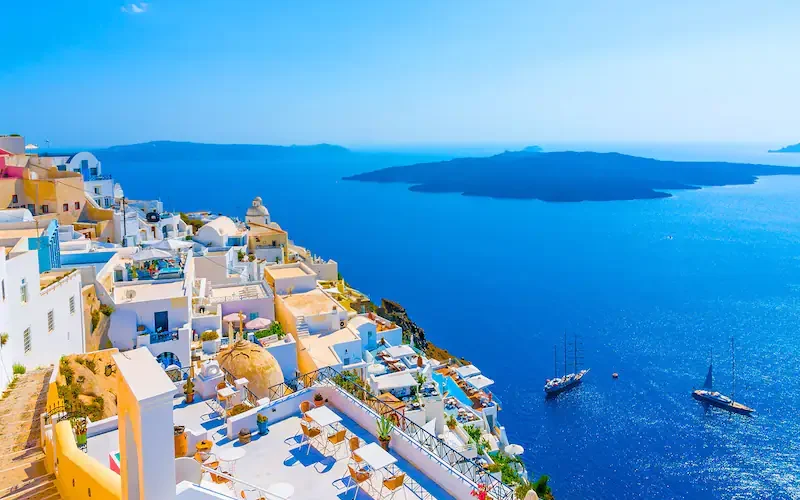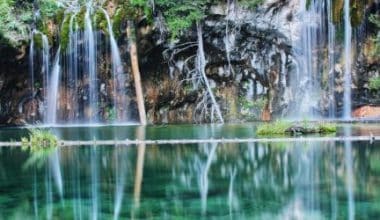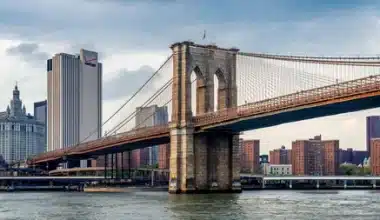It’s no surprise that Greece ranks among Europe’s top travel destinations, with its abundance of ancient ruins, whitewashed villages, sunny beaches, tasty cuisine, and welcoming atmosphere. But the reason tourism exists in the first place is because this region is so beautiful. That beauty is often found on the many scattered islands that lie like little gems in the seas surrounding the Grecian peninsula. Each has its own set of breathtaking landscapes, historic sites, nightlife scenes, and cultural delights.
There are a plethora of these to discover. So it is easy to get confused about where to go in Greece when you visit. However, we have done the legwork, and here are the top places to visit in Greece:
Where to Go in Greece
Athens
If you’ve heard anything about Greece, you’ve probably heard about its beautiful capital, Athens. Athens is the ideal combination of traditional and trendy, ancient and modern, natural and cosmopolitan. There are huge, open roads lined with restaurants and bars here, but coming off them are tiny little cobblestone side streets to explore. Old structures give way to intriguing galleries. You can grab an ouzo and sit under the stars at a beautiful outdoor cinema. Plus, you must see the Parthenon at least once in your life. Athens is a sprawling, unparalleled beauty unlike any other. Make a note of it on your bucket list.
Crete
To explore Greece’s largest island, you’ll need a car, but if you’re looking for golden beaches, crumbling old towns, world-class museums, and UNESCO World Heritage sites, Crete has it all. The liveliest part of the island is Chania in the west, while Sitia in the east is known for its pristine coves and sandy beaches – a perfect rural and picturesque escape. Nature lovers can hike Samaria, Europe’s longest gorge, culture seekers can visit the Minoan palaces, and kids will have a blast at the island’s numerous waterparks.
Santorini
Santorini, one of the Aegean Sea’s Cyclades islands, appears to have been crafted by the Greek gods: whitewashed villages crown the island with views of its majestic coastlines, rural vineyards span vast stretches inland, and the beaches are black, red, and out of this world. There’s so much to discover for explorers, foodies, and culture vultures, from archaeological sites to swimming holes and delicious wine and food. And believe us when we say that this place is even more stunning in person than it appears on Instagram.
Zakynthos
Zakynthos, also known as Zante, attracts a party-hard crowd to its notorious Laganas nightlife strip, but this sun-kissed Ionian isle – known by Venetians as ‘the flower of the East’ – is also blessed with some of the Med’s most beautiful scenery. This includes the spectacular Shipwreck Beach, whose bright blue waters are hemmed in by sheer white cliffs and can only be reached by boat, as well as the Zakynthos Marine Park, which is home to slippery seals and astute turtles. It’s truly wild – in more ways than one.
Tinos
Tinos is another glory in the Cyclades archipelago, known for its carved marble-fronted buildings and, increasingly, its burgeoning food scene. To get there, fly to Mykonos and then take a ferry. It’s worth the trip because it produces some of the best Greek wines, and chefs from all over Europe have opened restaurants among its sage-scented hills. Most are in Chora’s main town, and we recommend Thalassaki’s traditional Greek menu.
Naxos
Naxos, the largest of the Cyclades islands, is also one of the least visited, so expect secluded sandy beaches and a low-key, laid-back atmosphere that will make the stresses of everyday life feel worlds away. This is a place where you can venture up into tiny high-flung mountain villages or laze on an endless chain of silky sand beaches away from the madding tourist crowds, packing an incredible amount of variety into an incredibly small space.
Corfu
If you visit the lush island where the Durrell family once lived, you can expect to see Italianate villages, ornate palaces, and romantic beaches. Corfu, with its various influences left by past invaders, is a place where you can drink ginger ale with your Greek salad, walk down streets lined with Byzantine and Venetian architecture, and meet modern-day monks in Paleokastritsa’s spectacular medieval monastery. And, after a long day of sightseeing and eating, you’ll undoubtedly want to jump right into the Ionian Sea, which is always a stunning shade of turquoise blue.
Rhodes
Back in the day – and we’re talking back in time – Rhodes was home to the Colossus, one of the world’s Seven Wonders. The island’s Unesco world heritage-listed old town may have been destroyed by an earthquake in 226 BC, but it retains its charm and history thanks to a series of dazzling topsy-turvy medieval inns and fourteenth-century knight’s houses that still stand today. Outside of the city, the mountain villages and cliff-top towns are just as magical as any fairytale setting. You’re also guaranteed some modern magic with the abundance of chic shops, decent restaurants, and lively bars.
Thessaloniki
Thessaloniki, once the second city of the Byzantine Empire and later a thriving Ottoman port connecting east and west, has only been a part of Greece since 1912. That is very clear. The central market, Kapani, has all the color and chaos of an Istanbul bazaar, and much Ottoman architecture remains throughout the city center – you can even visit the house where Mustafa Kemal Atatürk, the father of modern Turkey, was born. The harbourside Ladadika neighborhood has some of the wildest, most fun nightlife on the Balkan peninsula, with most bars and clubs open until 6 a.m. or later. The old town is ideal for a leisurely morning stroll, and the ouzo and bougatsa breakfast pastries are unrivaled in these parts.
Kalamata
The Peloponnese city of Kalamata is home to the ancient ruins of Messenia, the picturesque Navarino Lagoon beach, and those very famous olives from which the name derives. Few tourists visit these areas, which is fantastic news for you. To explore the surrounding area, stay at the Ant Farm, a lovely farmhouse just outside the city where you can stay in one of ten treehouses nestled among the olive trees.
Mykonos
Mykonos, dubbed the “Greek Ibiza,” is where world-famous DJs headline superclubs while a jet-set crowd mingles on yachts and private jets. This Cyclades island, however, is not just for the wealthy: there are plenty of cute hotels, affordable gourmet restaurants, and quiet corners that have remained relatively untouched by the tourism industry. So, after you’ve exhausted the beach clubs and traditional tavernas, simply follow the tangled web of dirt-strewn backroads – chances are, a heavenly beach awaits at the end.
Cape Sounion
Cape Sounion, located at the southernmost tip of the Attica peninsula, is best known for the ruins of the ancient Greek temple of Poseidon, the god of the sea.
The ruins are perched on a cliff overlooking the sea on three sides. The site is a popular day trip from Athens for tourists, with the sunset over the Aegean Sea from the ruins a must-see.
Zagori
In northwestern Greece, Zagori is a region of great natural beauty, with striking geology and two national parks. Its dense forests and rugged mountains are carved by powerful rivers and dotted with traditional villages, many of which feature grand stone houses from the late 18th century.
Hiking the numerous paths connecting the villages is the best way to enjoy the area. The wonderful Vkos Gorge is the most accessible and rewarding destination.
Halkidiki
Halkidiki is a trident-shaped peninsula near Thessaloniki with beautiful beaches. The three distinct peninsulas can be summarized as follows: Kassandra has a vibrant nightlife, Sithonia has beautiful beaches, and Athos has monks.
Kassandra is more developed because it is closer to Thessaloniki, whereas Sithonia is more peaceful and has campgrounds, hidden coves, and clear waters. Both are popular among Greek and Eastern European visitors. The Mount Athos monastic community owns much of the easternmost peninsula. It is only accessible by boat and is only open to male pilgrims.
Peloponnese
Peloponnese was traditionally known as Morea, which means mulberry leaf, due to its shape resembling a large leaf. It is a wide peninsula connected to the mainland by the Rio-Antirrio bridge, located in the southernmost region of both Europe and Greece.
Peloponnese, with its classical Greek temples, Venetian fortresses, Byzantine churches, and Mycenaean palaces, echoes ancient cultures and events from its long history. Olympia, where the first Olympic Games were held in honor of Zeus, is one of these ancient ruins.
Delphi
This location is Greece’s most visited archaeological site, second only to Athens’ Acropolis. Delphi, located about two and a half hours from Athens on the slopes of the majestic Mount Parnassus, was once revered as the center of the earth by the ancient Greeks. Delphi was an important oracle dedicated to the god Apollo.
People used to come to this sacred site to seek advice from the priestess on a variety of topics ranging from farming to relationships and politics. The Temple of Apollo, the Athenian Treasury, and the theater and hippodrome that once hosted the ancient Pythian Games are all significant ruins and structures at Delphi.
Meteora
The Greek word Meteora means “suspended in the air,” and this phrase perfectly describes the spectacular cliffs that rise more than 1,200 feet (366 meters) above the villages of Kalambaka and Kastraki in Greece’s north-central mainland.
The historic monasteries perched along the summits add to the awe of these cliffs. Monks seeking spiritual isolation and freedom from religious persecution built the monasteries at Meteora in the 14th and 16th centuries.
Greek Islands
Every year, tourists flock to the beautiful and exotic Greek islands, making them one of the world’s top travel destinations. With over 2,000 islands to choose from, they may be confused at first by their sheer number and variety. The Greek islands have it all: beautiful beaches, ancient ruins, colorful harbors, and active volcanoes.
Santorini, part of the Cyclades group, is one of the most picturesque islands and unquestionably one of the best places to visit in Greece. Mykonos, another Cycladic island, has a modern, cosmopolitan society mixed in with traditional whitewashed houses and winding streets. Rhodes is the capital and largest island of the Dodecanese archipelago, located in the Aegean Sea near the coast of Turkey. It is known for its beautiful beaches and historical significance. Corfu, the northernmost of Greece’s Ionian Islands, was controlled by many foreign powers, most notably the Venetians and British, which is reflected in the island’s culture and architecture.
What is the most famous part of Greece?
The Acropolis is widely regarded as one of the best tourist destinations in all of Greece, and it can be found in Athens. This UNESCO World Heritage Site is an absolute must-see for anyone who has even the slightest interest in history or old ruins.
Which is more beautiful Greece or Italy?
When comparing Greece and Italy, there is no one clear winner when it comes to the question of which country is more beautiful. They are both one of a kind and provide visitors with scenery that is captivating. The most famous thing about Greece is probably all of its beautiful islands. At some point in one’s life, everyone should make it to Santorini and take in the view of the caldera.
Is it cheap to stay in Greece?
In 2023, the number of available rooms in Greece will be significantly reduced. You can always count on finding a good number of hostels and homestays in Greece, particularly on the more tranquil islands that you visit while island hopping. If not cheaper, you should have no trouble finding a hostel or a hotel with a nightly rate between $40 and $80, and possibly even lower.
Related Articles
- Vogue Logo: What is the Meaning of the Brand?
- What is the average living cost per month in Athens, Greece?
- HARRY POTTER LOGO: The History of Magic
- CHAMPION LOGO: The Early History of the Athletics Brand Champion
- WONDER WOMAN LOGO: History, Transitions & Meaning






